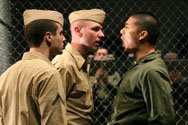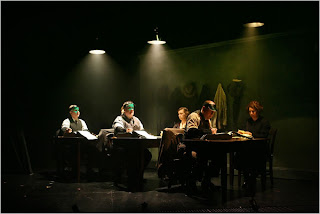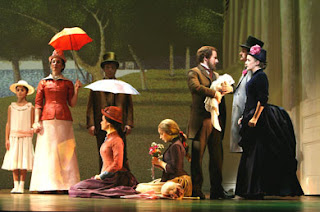
"The Brig" is unlike anything I can remember ever having seen on stage. Set in a Marines jail, there is little plot, character development, or dialogue in this fascinating play. There is, however, intense theatrical poetry.
The first act, which is probably nearly an hour long, is a carefully choreographed acting out of the prisoner's day. We see them change their clothes, make their beds, march off to the bathroom, and read their marines manuals. The prisoners are sometimes barked at by the wardens but the soundtrack of this play is provided by the heavy panting of the actors as they march/stomp and run across the stage and as they scream their request for permission to cross the various white lines laid out across the brig. Once the ten prisoners are awakened by the wardens, the play is a flurry of activity, all highly coordinated, all intensely physical, and all terribly impersonal. It's like a fucked up version of watching a marching band up close. The sense of the lives of the men in the marines is conveyed through a highly intense bodily experience and the drama of the play is the acting out of the demands and difficulty of these lives.
I was fascinated to watch a play without dialogue communicate a deep sense of the experience of being a soldier. Still, at the end of act one, I was praying for some dialogue and a plot in the second act. I didn't get any such thing but what I got was masterful. Having set the scene of the ordinary day for these soldiers in act one, act two provides scenes that act as relief against the first act. For example, there's a scene in which the men clean the brig. If they clean it well enough, they are told, they will get a half hour to write letters. As an audience member, you pray that they receive this half hour because you sense they desperately need the break from this awful physical routine to survive with their sanity intact and because you need a break from the choreography of loud sound and repetitive action. This is where the drama lies in the show. A very different kind than we typically experience in theater. Its story is boiled down to emotion and conveyed in a unique way. As the men frantically wash the brig, things become frantic, almost slapstick, and one gets the sense of the chaos that lives just beneath the surface of this military routine. At any moment, it seems, these men could fall out of marching step and pandemonium could ensue. Or, perhaps more accurately, just beneath of the surface of the gloss and physical order of military life each soldier experiences a personal chaos and is part of a larger one.
Set against the order witnessed in the first act, the second act is remarkable. Among the things we witness is a prisoner leaving and a prisoner arriving. The prisoner leaving, we learn, is getting out five days early for good behavior. This is a serious disruption of the audience's assumptions. It means that in a world where one has no choice about how to behave, one can actually be deemed to have behaved well. Furthermore, and more to the point, it means that the wardens recognize the difficulty of these mens' lives and feel sympathy for them. This is jarring because it seriously disrupts our understanding of them as cold, mean, machines. Finally, we witness a prisoner's arrival, seeing how he learns all of these seemingly arbitrary rules (one can't ever have one's bare feet touch the ground, for example). After about five minutes of the soldier learning by making mistakes and being punished, a warden tells the new prisoner that another prisoner will explain the rules to him. This is the only time he will ever be engaged in a conversation, he is told. Once the explanation of the rules is complete, he will never speak to another human being, he will only receive and ask for orders. Having just witnessed two hours of this kind of life, this short bit of relief, or counterpoint, leaves us devastated. We feel what they have missed largely being seeing it happen for 30 seconds.
I have given away a lot about this play but there's so much more. And it's something to see. After the show, an actor friend of mine said he can't imagine why any actor would want to be in that show. He pointed out how hard they work in the production, both physically and emotionally, and guessed that they were all backstage feeling isolated and angry with each other. I replied that this was Los Angeles and that maybe they're willing to be in any play to get noticed. He pointed out that it's impossible to get noticed in that play -- everyone does everything the same way at the same time and emotion isn't conveyed in such a way that one recognizes the work of an individual actor. As in the world of the marines that this play reflects, there is no individuality and the bits of humanity present are rarely witnessed.



